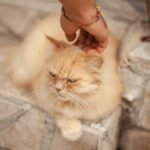Have you ever wondered what your cat would truly be like if it knew—deep down—that it was absolutely safe with you? The transformation can be astonishing. Even the most timid feline can unfold into a confident, loving companion once it feels secure. Emotional safety is the invisible foundation for a cat’s happiest, quirkiest, and most affectionate behaviors. Let’s unravel the secret world of cats who have finally let their guard down. If you’re a cat lover, these next twelve behaviors might just warm your heart—or surprise you!
1. Kneading With Their Paws

Once a cat feels emotionally safe, you’ll often notice it kneading soft surfaces with its paws. This adorable behavior, sometimes called “making biscuits,” is actually rooted in kittenhood. When kittens nurse, they knead their mother to stimulate milk flow. In adult cats, kneading means comfort and trust. A cat that kneads on your lap or favorite blanket is expressing a deep sense of contentment and security. It’s their way of saying, “I feel at home here.” If your cat kneads until it drifts off to sleep, that’s an even stronger sign of emotional safety. Rather than being on high alert, your cat is reliving the safest memories of its life, all thanks to you.
2. Slow Blinking at You

Have you ever caught your cat gazing at you and blinking slowly? This is one of the most touching signs of feline trust. In the wild, closing one’s eyes is a vulnerable act, so when a cat chooses to slow-blink at you, it’s showing that it feels safe enough to lower its guard. Many cat behaviorists even call this the “kitty kiss.” If you want to communicate love back, try slow-blinking in return. Over time, this gentle exchange can strengthen your bond even further. It’s a silent conversation that says, “I trust you, and you can trust me too.”
3. Showing Their Belly

A cat’s belly is its most sensitive area, and exposing it is a sign of true confidence. When a cat flops down and sprawls out, showing its soft underside, it’s making itself completely vulnerable. This isn’t just about relaxation—it’s a statement of absolute trust. Not every cat wants belly rubs, but the act of revealing the belly means your cat feels no threat in your presence. You may notice this behavior more often when your home is quiet and peaceful, because stress-free environments help cats feel secure enough to let it all hang out. It’s a heartwarming sight that never gets old.
4. Seeking Out Cuddles on Their Own

Some cats are naturally aloof, but once emotional safety is established, even the shyest felines may start seeking out physical closeness. Watch for moments when your cat curls up next to you without being prompted. This voluntary affection is a giant leap forward from cautious distance. It means your cat sees you as a safe haven. Cuddling isn’t just about warmth—it’s about emotional connection. Your cat’s decision to nap against your side or atop your chest is a powerful vote of confidence in your relationship.
5. Chirping and Chattering

Cats have an entire secret vocabulary, and feeling safe unlocks some of their funniest sounds. Chirping and chattering are noises cats make when they’re excited, playful, or even a little frustrated. You might hear these sounds when your cat watches birds through the window or greets you after a long day. Insecure or anxious cats are often silent, but a safe, secure kitty will “talk” in all sorts of surprising ways. These cheerful vocalizations are your cat’s way of expressing joy and anticipation in a safe environment.
6. Following You Room to Room

If your cat starts to play the role of your shadow, congratulations—you’re trusted! Cats that feel emotionally secure often want to be wherever you are. They’ll pad along behind you from room to room, sit nearby as you work, and generally keep tabs on your activities. This behavior isn’t about separation anxiety; it’s a sign that your cat enjoys your presence. It may even wait outside the bathroom door or greet you at the door when you come home. The simple act of following you shows your cat feels comfortable and included in your daily routine.
7. Bringing You “Gifts”

It might not always be pleasant, but when your cat brings you a toy—or, in the case of outdoor cats, something it’s hunted—it’s actually a sign of affection and trust. In the wild, cats share food with those they care about. By dropping a mouse, bird, or favorite stuffed animal at your feet, your cat is saying, “You’re part of my family.” While you might wish your gifts were less… lively, it’s important to remember the love behind the gesture. It takes emotional security for a cat to share its prized possessions with you.
8. Sleeping in Open, Vulnerable Spots

A frightened or anxious cat will hide away to sleep, often squeezing into tight, hard-to-reach places. But a cat that feels emotionally safe will choose open, visible spots for its naps. This could be the middle of the couch, the sunny windowsill, or even right in the center of the hallway. Sleeping out in the open demonstrates a high level of trust. Your cat isn’t worried about sudden threats or disturbances. This behavior is a clear message that your home is, in every sense, its sanctuary.
9. Playful, Kitten-Like Antics

Safety brings out a cat’s inner kitten. When a cat feels secure, it will engage in playful antics—chasing toys, pouncing on invisible prey, or even racing around the house in a sudden burst of energy. Play is a luxury for animals; it only happens when basic needs like safety are met. If your cat suddenly starts batting at strings, leaping after shadows, or inventing elaborate games, it’s a wonderful sign. This return to playful innocence is both hilarious and moving. Your cat is finally having fun, free from fear.
10. Gentle Head Butting

Head butting, also known as “bunting,” is one of the most affectionate feline gestures. When your cat bumps its head against you, it’s not just asking for attention—it’s marking you with its scent. Cats have scent glands on their heads, and by rubbing against you, they’re leaving a message: “You’re mine, and I’m yours.” This behavior only emerges when a cat feels deeply safe and bonded. It’s a quiet, loving way for your cat to claim you as part of its world.
11. Grooming You or Other Pets

A cat that grooms you, licking your hands or hair, is extending one of the highest honors in the cat world. Grooming is a social behavior reserved for family and close friends. By sharing this intimate ritual, your cat is saying that you belong together. You might also notice your cat grooming other pets in the household, which is a sign of harmony and trust. Allogrooming (mutual grooming) is a strong indicator that your cat feels emotionally safe and at ease in its environment.
12. Exposing Their Tail in an Upright Position

A cat’s tail is a mood barometer. When a cat walks toward you with its tail held high and the tip slightly curved, it’s a universal sign of happiness and confidence. In feline language, an upright tail means “I’m friendly and open to interaction.” Cats that feel scared or uncertain tend to keep their tails low or tucked away. The proud, upright tail is your cat’s way of waving hello and showing it feels good in your presence. It’s a beautiful, often overlooked signal of security and affection.

Growing up traveling and experiencing new cultures and wonders, I have had a passion for nature, adventuring, photography, and videography. I am currently working towards a BSc in Biodiversity and Ecology at Stellenbosch University, and I hope to specialise in Marine Sciences one day.
Please send any feedback to Feedback@animalsaroundtheglobe.com






